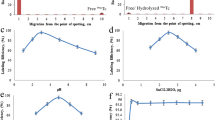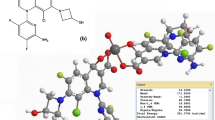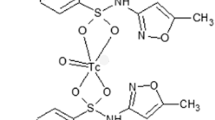Abstract
Sitafloxacin dithocarbamate (SFDE) was synthesized, radiolabeled with technetium-99m (99mTc) using [99mTc-N]2+ core and evaluated its biological efficacy as a potential radiotracer for Staphylococcus aureus (S. aureus) infection in artificially infected rats (AIRT) and rabbits (AIRB). The radiochemical stability of the 99mTc labeled SFDE (99mTcN-SFDE) in saline and serum was determined by radio-HPLC and TLC methods, respectively. After, 1 min of reconstitution the value of radiochemical purity (RCP) was 99.00 ± 0.20% and was remained more than 90% unwavering even after 240 min of the radiolabeling. The 99mTcN-SFDE complex showed similar radiochemical permanence behavior in serum at 37 °C. The complex showed almost six fold higher specific in vitro binding with living than heat killed S. aureus. Biodistribution behavior was evaluated in S. aureus AIRT and whole body imaging (WBI) in AIRB, respectively. Seven fold up take was observed in infected muscle of the AIRT as compared to inflamed and normal muscles. The disappearance of activity from blood and appearance in urinary system indicated normal route of excretion of the complex. Scintigraphically, it was confirmed that the labeled SFDE was higher accumulated in the infected muscle higher than in inflamed and normal muscle. The high radiochemical stability in saline and serum, specific in vitro binding with S. aureus, precise in vivo distribution in S. aureus AIRT and targeted WBI in AIRB confirmed the possibility of the 99mTcN-SFDE complex as a potential and promising S. aureus infection radiotracer.
Similar content being viewed by others
Avoid common mistakes on your manuscript.
Introduction
The localization and discrimination of in vivo infection from non-infective inflammatory processes and tumors at early stages with scintigraphic procedures is a fast growing area of research [1]. The scintigraphic procedures are proven clinically vital in the early understanding of the disease processes at molecular levels without the inconvenient invasive techniques, if a specific ligand is provided [2].
A number of infection imaging agents were reported including the most promising 111In or 99mTc labeled leukocytes after the development of 67Ga-citrate. However, due to lack of wide availability, high radiation burden, cumbersome and time consuming preparation procedure etc. have opened new ways for the development of newer and better radiopharmaceuticals for in vivo localization of infection [3, 4].
The extensive evaluation of the 99mTc-nitridio complexes has been recently explored as a novel radiolabeling technique for the development of newer and better radiopharmaceuticals. The complexation of [99mTcN]2+ core with ligand containing sulfur atom was found more stable [5, 6].
In continuation to our ongoing investigations [7–11] and other reported studies on technetium-99m (99mTc) labeled antibacterial agents [12–20], the present investigation is focused on the modification of sitafloxacin (STF) to sitafloxacin dithiocarbamate (SFDE) (Fig. 1a) and its radiolabeling with 99mTc via [99mTcN]2+ core. The percent radiochemical purity (% RCP) yield, in vitro stability in saline and serum, in vitro binding with bacteria, and biodistribution in artificially infected rats and scintigraphic were evaluated.
Experimental
Materials
Sitafloxacin (STF) (Daiichi Sanko, Japan), succinic dihydrazide (SDH), propylenediamine tetra acetic acid (PDTA) (Aldrich, USA) and all the other chemicals and solvents of analytical grade (Sigma)., RP-HPLC (Shimadzu, Japan), well counter, scalar count rate meter (Ludlum, USA), Dose calibrator (Capintech USA) and the Gamma camera (GEADE Nuclearmedizine system, Germany).
Method
Synthesis of sitafloxacin dithiocarbamate (SFDE)
Sitafloxacin (STF) was modified to sitafloxacin dithiocarbamate (SFDE) using the reported method [14] with slight modification, briefly, sodium hydroxide (NaOH) 1.2 gm was mixed with 3.625 gm of STF.HCl in a clean sterilized flask having 11 mL of 40% tetrahydrofuran. The mixture was stirred for 10 min in ice-bath followed by addition of 1 mL carbon disulfide (CS2). The mixture was stirred continuously for 8 h in an ice-bath. The solvent was removed under reduced pressure and the product was recovered.
Radiosynthesis of 99mTcN-SFDE complex
99mTcN-SFDE complex was prepared by adding 1 mCi (0.5 mL) of freshly eluted sodium pertechnetate (Na 99m2 TcO4) to a preparation containing 0.05 mg stannous chloride dihydrate, 5.0 mg PDTA and 5.0 mg SDH. After 10 min, 2 mg (1 mL saline) of SFDE was added to the preparation followed by incubation at room temperature for 10 min.
Radiochromatography
HPLC was used to determine the percent radiochemical purity (% RCP) of the 99mTcN-SFDE complex using the reported method with minor modifications [9]. Briefly, 5 μL of the preparation was injected into C-18 column (4.6 × 150 mm, 5 μM) of the shimadzu SCL-10 AVP system, equipped with SDP-10 AVP UV detector operating at 254 nm, Packard 500 TR series flow scintillation analyzer, binary pump, and online degasser followed by 1 mL/min water:acetonitrile (1:9) elution. The fractions collected separately were checked for activity using well counter interface with scalar count rate meter (WCSR). The preparation was examined at 30, 60, 90 and 120 min after radiolabeling for % RCP.
Stability in serum
TLC with two mobile systems was used for in vitro stability determination of the 99mTcN-SFDE complex in human serum. The 99mTcN-SFDE complex, 0.2 mL was incubated with 1.8 mL serum for 120 min at 37 °C. Thereafter, 1 μL of the preparation was applied to the TLC strip and after drying developed in two different mobile systems. The one is saline in which 99mTcO4 −, 99mTcO2 and the complex stayed at the application point while the intermediate [99mTcN]2+ moiety move with the solvent front. However, in acetone as mobile phase the complex and [99mTcN]2+ moiety stayed at the origin. The TLC strips developed in different mobile phases were analyzed for activity using well counter.
In vitro binding with Staphylococcus aureus
In vitro binding behviour of the 99mTcN-SFDE complex was investigated using the reported method [21]. Briefly, 10 MBq of the 99mTcN-SFDE in 0.1 mL of sodium phosphate buffer (Na-PB) was transferred to a clean and sterilized test tube. Thereafter, 0.8 mL of 50% (v/v) 0.01 M acetic acid in a Na-PB containing approximately 1 × 108 colony forming units (CFU) of S. aureus, were added. The mixture was then incubated at 4 °C for 1 h (pH 5). The mixture after 1 h was centrifuged for 5 min at 2000 rpm. The bacterial pellets were resuspended after the removal of supernatant in 1 mL Na-PB and recentrifuged. The S. aureus pellets after removal of the supernatant analyzed for % activity using well counter.
Animal model and biodistribution
Healthy, Sprague–Dawley male rats (weight rage 150–200 g) 18 in number were selected and placed in two groups. The rats of group 1 and 2 were infected intramuscularly (I.M.) with 0.5 mL living S. aureus and heat killed S. aureus (right thighs), respectively. After 12 h, 0.5 mL of sterile turpentine oil was injected I.M. into the left thigh of all the model rats followed by intravenous (I.V.) injection of 0.1 mL (37 MBq) of 99mTcN-SFDE. The model rats were sacrificed in accordance with the guide lines of the Nuclear Medicine Research Laboratory, University of Peshawar. Percent injected absorbed dose (% I.D/g) in one gram of blood, S. auras infected (SAI), inflamed (NT), normal (NR) muscle, liver, spleen, stomach, intestine, and kidney of the model rats were calculated using gamma well counter.
Whole body imaging
The imaging silhouette of the 99mTcN-SFDE was evaluated in animal model New Zealand white rabbits (weight range 3.0–4.0 kg). In saline, 1 mL containing 1 × 108 CFU of the S. aureus was intramuscularly administered to the right thigh of the healthy rabbit followed by 1 mL sterile turpentine oil (with a 12 h gap) to the left thigh. Thereafter, 0.4 mL (111 MBq) of 99mTcN-SFDE was I.V. injected through ear vein of the model rabbit. Whole body imaging of the model rabbit was processed using gamma camera (GC) equipped with low energy general purpose collimator (LEGPC).
Results and discussion
The SDH in a kit acts as an efficient source nitride nitrogen (N3−) and stannous chloride as reducing agent and the PDTA avert the formation of insoluble salt of tin. The SDH in the presence of stannous chloride react with sodium pertechnetate to give an intermediate [99mTcN]2+ core that under substitution reaction with SFDE, yield 99mTcN-SFDE complex.
Radiochromatography
The HPLC radio-chromatogram (Fig. 2) of the 99mTcN-SFDE showed two distinctively variable peaks with retention time 3.2 and 10.5 min. The radioactivity peak at 3.2 and 10.5 min represents the intermediate [99mTcN]2+ core and 99mTcN-SFDE, respectively. The RCP of the 99mTcN-SFDE complex determined at various intervals after reconstitution is shown in Fig. 3. The maximum RCP observed was 99.00 ± 0.20% at 1 min.
By analogy with the molecular structure of bis(diethyldithiocarbamato) nitride 99mTc complex [22]. It seems reasonable to propose a similar structure for 99mTcN-SFDE complex having a square pyramidal geometry with 1:2 stoichiometry of the 99mTcN:Ligand. The proposed structure of the 99mTcN-SFDE complex is given in Fig. 1b.
Serum stability
The in vitro permanence of 99mTcN-SFDE complex in serum at 37 °C after reconstitution is shown in Fig. 4. The complex was found stable more than 90% up to 4 h and the stability went down up to 78.10 ± 0.90% within 16 h.
In vitro binding with Staphylococcus aureus
The complex showed saturated in vitro binding to the living but not to the heat killed S. aureus. No effect was observed on adding additional SFDE in incubation. The in vitro binding affinity of the 99mTcN-SFDE complex is shown in Fig. 5.
Biodistribution
The uptake of the 99mTcN-SFDE in different organs of the animals infected with living and heat killed S. aureus is given in Table 1. The uptake was significantly low in heat killed S. aureus infected group of animals as compared to the living. Initially, the activity in blood, liver, spleen, was much higher than in kidney and urine but after 60 and 90 min a reciprocal contour was observed in the group of animals infected with living S. aureus. Seven fold uptake in the target organ (SAI) was observed in a groups of 9 animals infected with living as compared to the heat killed S. aureus. The distribution of the labeled SFDE in different organs and absconding from blood, liver, spleen, and appearance in the kidney confirmed the normal route of excretion and seven fold accumulations in the infected muscle confirmed the normal route of excretion and promising S. aureus in vivo infection radiotracer.
Scintigraphy
Scintigraphically, our findings confirmed that initially the radiolabeled from blood stream accumulated into the liver and spleen. Thereafter, specifically the 99mTcN-SDEF appeared in the infected sites and renal system. Almost negligible uptake was seen in NT and NR muscle of the infected rabbit as shown in Fig. 6.
Conclusion
Sitafloxacin was modified to sitafloxacin dithiocarbamate and labeled with 99mTc-N core through ligand exchange reaction and evaluated as a potential Staphylococcus aureus (S. aureus) infection radiotracer. The complex showed high in vitro permanence in saline and serum, better in vitro binding affinity with S. aureus, promising biodistribution behaviour in S. aureus infected rats and fine scintigraphic results in S. aureus infected rabbits. Based on the above findings we recommended the 99mTcN-SFDE complex for in vivo infection localization in human.
References
Bruggen W, Bleeker-Rovers CP, Boerman OC, Gotthardt M, Oyen WJG (2010) PET and SPECT in osteomyelitis and prosthetic bone and joint infections: a systematic review. Semin Nucl Med 40:3
Basu S, Chryssikos T, Moghadam-Kia S, Zhuang H, Torigian DA, Alvai A (2009) Positron emission tomography as a diagnostic tool in infection: present role and future possibilities. Semin Nucl Med 39:36
Gallagher H, Ramsay SC, Barnes J, Maggs J, Cassidy N, Ketheesan N (2006) Neutrophil labeling with [99mTc]-technetium stannous colloid is complement receptor 3-mediated and increases the neutrophil priming response to lipopolysaccharide. Nucl Med Biol 33:433
Lahiri S, Sarkar S (2007) Studies on 66, 67 Ga- and 199Tl-poly(N-vinylpyrrolidone) complexes. Appl Radiat Isot 65:309
Zhang J, Wang X, Tian C (2006) Synthesis of a bis-(N-butyl-dithiocarbamto)-nitrido 99mTc complex: a potential new brain imaging agent. J Radioanal Nucl Chem 273:15
Zhang J, Wang X (2000) Synthesis of 99mTcN(IPDTC)2 and its biodistribution in mice. J Radioanal Nucl Chem 249:573
Qaiser SS, Khan AU, Khan MR (2010) Synthesis, biodistribution and evaluation of 99mTc-Sitafloxacin kit : a novel infection imaging agent. J Radioanal Nucl Chem 284:189
Shah SQ, Khan AU, Khan MR (2010) Radiosynthesis of 99mTc-nitrifuratonin a novel radiotracer for in vivo imaging of Escherichia coli infection. J Radioanal Nucl Chem
Shah SQ, Khan AU, Khan MR (2010) Radiosynthesis and biodistribution of 99mTc-rifampicin: a novel radiotracer for in vivo infection imaging. Appl Radiat Isot 68:2255
Shah SQ, Khan AU, Khan MR (2010) 99mTc-Novobiocin: a novel radiotracer for infection imaging. Radiochimica acta
Shah SQ, Khan AU, Khan MR (2010) Radiosynthesis, biodistribution and scintigraphy of the 99mTc-Teicoplanin complex in artificially infected animal models. J Labeled Comp Radiopharm
Hong Z, Ningyi J, Lin Z (2009) Experimental studies on imaging of infected site with 99mTc-labeled ciprofloxacin in mice. Chin Med J 122:1907
Oh SJ, Ryu J, Shin JW, Yoon EJ, Ha H, Cheon JH, Lee HK (2002) Synthesis of 99mTc-ciprofloxacin by different methods and its biodistribution. Appl Radiat Isot 57:193
Zhang J, Guo H, Zhang S, Lin Y, Wang X (2008) Synthesis and biodistribution of a novel 99mTcN complex of ciprofloxacin dithiocarbamate as a potential agent for infection imaging. Bioorg Med Chem Lett 18:51
Motaleb MA (2007) Preparation of 99mTc-cefoperazone complex, a novel agent for detecting sites of infection. J Radioanal Nucl Chem 272:167
Motaleb MA (2007) Preparation and biodistribution of 99mTc-lomefloxacin and 99mTc-olfloxacin complex. J Radioanal Nucl Chem 272:95
EL-Gany EA, EL-Kolaly MT, Amine AM, EL-Sayed AS, Abdel-Gelil F (2005) Synthesis of 99mTc-pefloxacin:A new targeting agent for infectious foci. J Radioanal Nucl Chem 266:131
Roohi S, Mushtaq A, Jehangir M, Ashfaq MS (2006) Synthesis, quality control and biodistribution of 99mTc-Kanamycin. J Radioanal Nucl Chem 267:561
Motaleb MA (2009) Preparation, quality control and stability of 99mTc-sparafloxacin complex, a novel agent for detecting sites of infection. J Labelled Comp Radiopharm 52:415
Chattopadhyay S, Das SS, Chandra S, De K, Mishra M, Sarkar BR, Sinha S, Ganguly S (2010) Synthesis and evaluation of 99mTc-moxifloxacin, a potential infection specific imaging agent. Appl Radiat Isot. 68: 314
Welling MM, Paulusma-Annema A, Batler HS, Pauwels EKJ, Nibbering PH (2000) Technetium-99m labelled antimicrobial peptides discriminate between bacterial infections and sterile inflammations. Eur J Nucl Med 27:292
Baldas J, Bonnyman J, Poer PM, Williams GA, Mackay MF (1981) Synthesis And Structure of bis(diethyldithiocarbamato)nitridotechnetium(V)—a technetium-nitrogen triple bond. J Chem Soc Dalton Trans 9:1798
Author information
Authors and Affiliations
Corresponding author
Rights and permissions
About this article
Cite this article
Shah, S.Q., Khan, A.U. & Khan, M.R. Radiosynthesis and biological evaluation of 99mTcN-sitafloxacin dithiocarbamate as a potential radiotracer for Staphylococcus aureus infection. J Radioanal Nucl Chem 287, 827–832 (2011). https://doi.org/10.1007/s10967-010-0833-9
Received:
Published:
Issue Date:
DOI: https://doi.org/10.1007/s10967-010-0833-9










